| |
SELF-DECEPTION OR PILL FOR HAPPINESS? That is the question that one wants to ask after having seen "Agitation for happiness" at Liljevalch's Exhibition Hall. One risks being viewed as a cynic if one does not choose the former, but I cannot give a definite answer.
So the question shall remain.
 In its historical context, Soviet public art emerges as the only possible alternative. The country was at war, politically, with the whole world. When the "Great Patriotic War" broke out, it became clear that any form of experimentation or doubt within the art world constituted suicide. The margins for the interpretation of art were reduced to a minimum. Clarity and unambiguousness were the only conceivable alternatives in that situation. The nation mobilized all of its resources in a struggle against the powerful enemy. The situation was most critical. The battle was fought within the country. It was a matter of either winning or going under. Art, along with the powerful rocket artillery "Kachusha", had become a weapon. The simple truth of the situation was that the Russian soldiers at the front needed models with which to anchor their identity and make their situation manageable. The function of art was reduced to education. For an outsider, it would be easy to draw the conclusion that art degenerated - but that is a matter of interpretation. In its historical context, Soviet public art emerges as the only possible alternative. The country was at war, politically, with the whole world. When the "Great Patriotic War" broke out, it became clear that any form of experimentation or doubt within the art world constituted suicide. The margins for the interpretation of art were reduced to a minimum. Clarity and unambiguousness were the only conceivable alternatives in that situation. The nation mobilized all of its resources in a struggle against the powerful enemy. The situation was most critical. The battle was fought within the country. It was a matter of either winning or going under. Art, along with the powerful rocket artillery "Kachusha", had become a weapon. The simple truth of the situation was that the Russian soldiers at the front needed models with which to anchor their identity and make their situation manageable. The function of art was reduced to education. For an outsider, it would be easy to draw the conclusion that art degenerated - but that is a matter of interpretation.
 Another aspect that one should consider, aside from the facts of war, is that there were those who truly believed in what they saw in the images. It was a serious intoxication, but many managed to live and die thinking that they had found the meaning of life. Another aspect that one should consider, aside from the facts of war, is that there were those who truly believed in what they saw in the images. It was a serious intoxication, but many managed to live and die thinking that they had found the meaning of life.
| "Praised be the Great Stalin!" by Yuri Kugach, 1950. (Click on the picture and a larger image will be displayed in a new window.) |
|
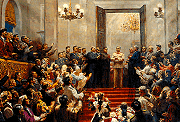 |
 The monumental painting, "Praised be the Great Stalin!" by Yuri Kugach was created according to all of the rules of the genre. A painting that illustrates its name which, in turn, complements the painting. That is all, nothing more to add. Such paintings were produced and reproduced in mass quantities. The goal was to spread joy and non-reflection. But did it work? One wonders today. Actually, it did, however paradoxical that may sound. There is standing evidence that the more outragous the lies, the easier it is for people to believe them. There seems to be some sort of need to hear sweet lies whispered in one's ear. The monumental painting, "Praised be the Great Stalin!" by Yuri Kugach was created according to all of the rules of the genre. A painting that illustrates its name which, in turn, complements the painting. That is all, nothing more to add. Such paintings were produced and reproduced in mass quantities. The goal was to spread joy and non-reflection. But did it work? One wonders today. Actually, it did, however paradoxical that may sound. There is standing evidence that the more outragous the lies, the easier it is for people to believe them. There seems to be some sort of need to hear sweet lies whispered in one's ear.
 The art enabled people to answer the questions of life, regain their orientation and through this achieve security and comfort. Strangely enough, many of the paintings seem oddly current here in the Sweden of the 1990s. One recognizes those healthy, running bodies with unbothered, happy faces. "It feels so familiar that it hurts", as one says in Russia. The art enabled people to answer the questions of life, regain their orientation and through this achieve security and comfort. Strangely enough, many of the paintings seem oddly current here in the Sweden of the 1990s. One recognizes those healthy, running bodies with unbothered, happy faces. "It feels so familiar that it hurts", as one says in Russia.
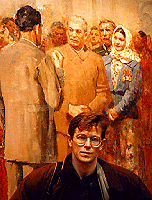 |
|
The author of this article in front of the painting "Our Wise Leader and Dear Teacher (Stalin Among the People at the Kremlin)", by Boris Joganson, 1952. |
 This art had what today's lacks - an immediacy between the image and the audience. Today's exhibition halls are empty and cold, and artists are very unsure about their role. The artist then was not a lost nomad, calling out in the desert or a modern artist with an acute need to maintain his or her vulnerable and shrinking self-esteem. Whether they were forced to choose this particular route in order to save their lives, or whether it was a free choice, that is a question that cannot be answered. There are heavily weighted arguments that speak for both alternatives. This art had what today's lacks - an immediacy between the image and the audience. Today's exhibition halls are empty and cold, and artists are very unsure about their role. The artist then was not a lost nomad, calling out in the desert or a modern artist with an acute need to maintain his or her vulnerable and shrinking self-esteem. Whether they were forced to choose this particular route in order to save their lives, or whether it was a free choice, that is a question that cannot be answered. There are heavily weighted arguments that speak for both alternatives.
 The painting "Discussion about Art" by Vasili Yakovlev is symptomatic for the end of the 1940s. After the victory over Nazi Germany, the country fell into a sort of euphoria with spectacular parades, elaborate buildings and a general atmosphere of triumph and celebration. This outpouring affected all branches of art including film, music, visual arts and architecture. The nation was transformed into an enormous theater with sets on a grand scale. This painting is completely in keeping with the times, excessive and exhausting to absorb. The painting "Discussion about Art" by Vasili Yakovlev is symptomatic for the end of the 1940s. After the victory over Nazi Germany, the country fell into a sort of euphoria with spectacular parades, elaborate buildings and a general atmosphere of triumph and celebration. This outpouring affected all branches of art including film, music, visual arts and architecture. The nation was transformed into an enormous theater with sets on a grand scale. This painting is completely in keeping with the times, excessive and exhausting to absorb.
| Vasili Yakovlev's "Discussion about Art", 1946. (Click on the picture and a larger image will be displayed in a new window.) |
|
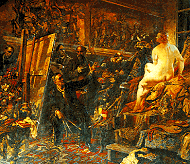 |
 One cannot mistake the painter's interest in the baroque. The theatrical gestures of the main figure, his comrades' movements loaned from art history, the overabundance of bric-a-brac, everything indicates that interest for the baroque was great. The fun part is the conflict between the actors. What sort of deceitful figure is that in the painting's left corner? Is it a KGB informant who pretends to be a friend? That we shall never know. But we do know that the artist's fascination for plump female bodies will outlive any dictatorship. It is strange that this painting could be created during the time of Stalinist censorship. Perhaps they were able to breath a little easier right after the war. One cannot mistake the painter's interest in the baroque. The theatrical gestures of the main figure, his comrades' movements loaned from art history, the overabundance of bric-a-brac, everything indicates that interest for the baroque was great. The fun part is the conflict between the actors. What sort of deceitful figure is that in the painting's left corner? Is it a KGB informant who pretends to be a friend? That we shall never know. But we do know that the artist's fascination for plump female bodies will outlive any dictatorship. It is strange that this painting could be created during the time of Stalinist censorship. Perhaps they were able to breath a little easier right after the war.
 The laquer box painting "Honor to the Heros from the Transpolar Flyover" has its roots in the aesthetic traditions of icon painting. It portrays three brownish figures squeezed between two groups of enormous buildings - the two superpowers, the Soviet Union and the United States. The actual story behind the painting is that they flew over the North Pole and back, between the United States and the Soviet Union, in rickety airplanes. We're first - we are better. We'll show those capitalist devils. The laquer box painting "Honor to the Heros from the Transpolar Flyover" has its roots in the aesthetic traditions of icon painting. It portrays three brownish figures squeezed between two groups of enormous buildings - the two superpowers, the Soviet Union and the United States. The actual story behind the painting is that they flew over the North Pole and back, between the United States and the Soviet Union, in rickety airplanes. We're first - we are better. We'll show those capitalist devils.
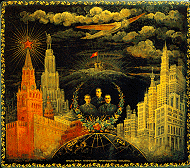 |
|
F.A. Kaurtsev's "Honor to the Heros from the Transpolar Flyover", 1939. (Click on the picture and a larger image will be displayed in a new window.) |
 Especially notable is the mimicry of the three faces. They portray three completely different emotions: fear, crazed peace and a schizophrenic craving for activity - three forces that caused a whole nation to run amok. In the left group of buildings we see the incomplete Palace of the Soviets. Construction had come to a halt at an early stage. And a Lenin statue has never been raised up so high, symbolizing the unrealized dreams and death of an ideology. Especially notable is the mimicry of the three faces. They portray three completely different emotions: fear, crazed peace and a schizophrenic craving for activity - three forces that caused a whole nation to run amok. In the left group of buildings we see the incomplete Palace of the Soviets. Construction had come to a halt at an early stage. And a Lenin statue has never been raised up so high, symbolizing the unrealized dreams and death of an ideology.
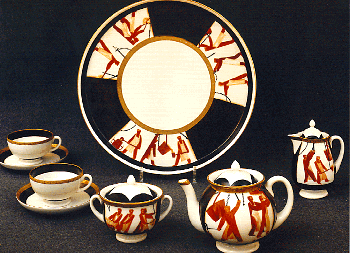
Porcelain set "Metal" (1930).
 The Porcelain set "Metal" from 1930 by Mikhail Mokh is simple and refined. Its brutal symbolism entices quick explainations. Take, for example, the large plate. There is neither a beginning nor an end. History repeats itself. The perfect, black forgetfulness alternates with the ringing sound of chains and splashing metal. One's gaze glides around the plate. Movement - rest, tick - tock, time passes, and in the middle of it all, the white axle of eternity. The Porcelain set "Metal" from 1930 by Mikhail Mokh is simple and refined. Its brutal symbolism entices quick explainations. Take, for example, the large plate. There is neither a beginning nor an end. History repeats itself. The perfect, black forgetfulness alternates with the ringing sound of chains and splashing metal. One's gaze glides around the plate. Movement - rest, tick - tock, time passes, and in the middle of it all, the white axle of eternity.
 There are, in fact, several quite bizarre paintings. One example is "Sportswoman" by Ivan Kulikov. The painting is simple. It portrays a young woman in sportswear of the time: a striped shirt, a red kerchief on the head, billowy shorts that look like a pulled up skirt. There are, in fact, several quite bizarre paintings. One example is "Sportswoman" by Ivan Kulikov. The painting is simple. It portrays a young woman in sportswear of the time: a striped shirt, a red kerchief on the head, billowy shorts that look like a pulled up skirt.
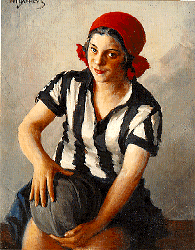
"Sportswoman" by Ivan Kulikov, 1929.
 The compositional center of the painting is a large black leather ball that the woman is holding in her hands. What is she doing with it? That is hard to decide. Twisting? Caressing? Trying to press it deeper in between her thighs under the skirtlike shorts? Her glittering black eyes bore themselves invitingly into those of the viewer. The painting is refreshingly funny. There is some form of connection being made between the woman's eyes, the viewer and the leather ball. A communication which can lead to perverse fantasies of the most vulgar type. In any event, this painting appeals to me with its unpretentious audacity. If one may paint such pictures, then one is allowed to live. The compositional center of the painting is a large black leather ball that the woman is holding in her hands. What is she doing with it? That is hard to decide. Twisting? Caressing? Trying to press it deeper in between her thighs under the skirtlike shorts? Her glittering black eyes bore themselves invitingly into those of the viewer. The painting is refreshingly funny. There is some form of connection being made between the woman's eyes, the viewer and the leather ball. A communication which can lead to perverse fantasies of the most vulgar type. In any event, this painting appeals to me with its unpretentious audacity. If one may paint such pictures, then one is allowed to live.
Fyodor Bogorodsky's "Youth".
Tranquil - or not that tranquil? |
|
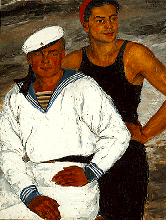 |
 The painting "Youth" by Fyodor Bogorodsky is tranquil and peaceful. There are two people. Things move around in circles when there are two. One is black and one is white. No difference in facial expressions between then and now. One sitting and one standing male person. A basis for Freudian interpretations? Unconscious or conscious homosexuality? No way! What did these two guys get to experience? The picture was painted in 1932. Nine years before the war. The red chieftain had already begun his harvest. How much longer do they have to live? One feels sorry for people. The painting "Youth" by Fyodor Bogorodsky is tranquil and peaceful. There are two people. Things move around in circles when there are two. One is black and one is white. No difference in facial expressions between then and now. One sitting and one standing male person. A basis for Freudian interpretations? Unconscious or conscious homosexuality? No way! What did these two guys get to experience? The picture was painted in 1932. Nine years before the war. The red chieftain had already begun his harvest. How much longer do they have to live? One feels sorry for people.
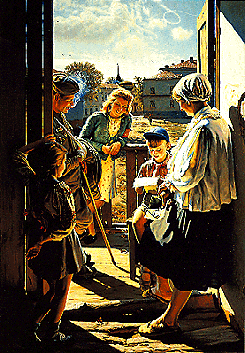
Aleksandr Laktionov's "Letter from the Front" (1962).
 Aleksandr Laktionov is a representative of Soviet photorealism. He was so calculating with his colors and achieved such remarkable results that one could suspect an icy indifference to his subjects. An escape into form? A hunt for perfection? Probably, yes. One can understand that it is sometimes difficult to endure the stresses of life. Do you see the sand under the feet? Aleksandr Laktionov is a representative of Soviet photorealism. He was so calculating with his colors and achieved such remarkable results that one could suspect an icy indifference to his subjects. An escape into form? A hunt for perfection? Probably, yes. One can understand that it is sometimes difficult to endure the stresses of life. Do you see the sand under the feet?
 "Commanders of the Red Navy" by Boris Yermolayev is impressive with its timeless, naive impartiality. The officers of the Red Navy stand, like black insects, under the portraits of their leaders. The magic of art - the partakers eventually disappear, but will swarm eternally. Eventually, the dark corridors of history will absorb them so that there is room for the next party. Already we see in the background, a few dark rooms with pictures on the walls. Who was swarming there? "Commanders of the Red Navy" by Boris Yermolayev is impressive with its timeless, naive impartiality. The officers of the Red Navy stand, like black insects, under the portraits of their leaders. The magic of art - the partakers eventually disappear, but will swarm eternally. Eventually, the dark corridors of history will absorb them so that there is room for the next party. Already we see in the background, a few dark rooms with pictures on the walls. Who was swarming there?
| From the unofficial department, naivist Boris Yermolayev and the "Commanders
of the Red Navy" (1934). |
|
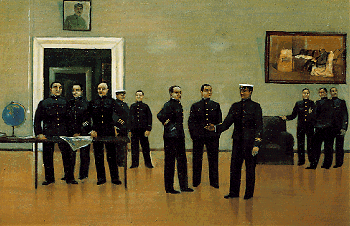 |
 The censors set high demands that the messages should go directly into the audience's brain without misinterpretation. From this standpoint, the painting "Shot Down Pilot" by Aleksandr Deyneka is very unusual. It is striking, easily remembered, and one wants to quote it. But at the same time it is completely unknown to me. The demand for immediate comprehension falls apart, paradoxically, in this seemingly very simple painting. The German pilot does not fall. He is soaring. This could upset the censor. One can imagine some possible lines of thought. One could, for example, interpret it as there being some sort of supernatural force that is preventing the pilot from falling, or that God loves all people equally, regardless of nationality or political orientation, be one a German or a Russian pilot or ... Is there a risk that the spectator will delve into philosophical speculation? The most paranoid of patterns could occur. The censors set high demands that the messages should go directly into the audience's brain without misinterpretation. From this standpoint, the painting "Shot Down Pilot" by Aleksandr Deyneka is very unusual. It is striking, easily remembered, and one wants to quote it. But at the same time it is completely unknown to me. The demand for immediate comprehension falls apart, paradoxically, in this seemingly very simple painting. The German pilot does not fall. He is soaring. This could upset the censor. One can imagine some possible lines of thought. One could, for example, interpret it as there being some sort of supernatural force that is preventing the pilot from falling, or that God loves all people equally, regardless of nationality or political orientation, be one a German or a Russian pilot or ... Is there a risk that the spectator will delve into philosophical speculation? The most paranoid of patterns could occur.
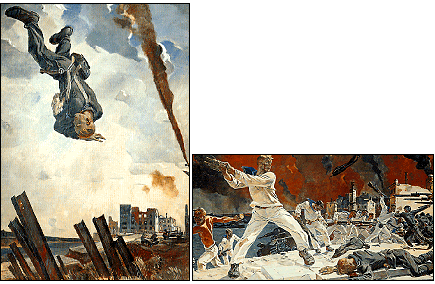
Aleksandr Deyneka: "Shot Down Pilot" (1943) and "The Defence of Sevastopol" (1942).
 From a purely technical standpoint, it is clear that these are two separate
paintings combined into one; the painting was a little too well planned out, which could have a negative effect. Considering the censorship paranoia which ruled during the Stalin era, it is not surprising that the painting did not receive much praise. On the other hand, the "Defence of Sevastopol" by the same artist, was one of the most quoted works. There is no room for interpretation here. Everything is crystal clear, one dimensional and concentrated. Here we are, there they are. We are on the right side and we struggle on to our last breath. From a purely technical standpoint, it is clear that these are two separate
paintings combined into one; the painting was a little too well planned out, which could have a negative effect. Considering the censorship paranoia which ruled during the Stalin era, it is not surprising that the painting did not receive much praise. On the other hand, the "Defence of Sevastopol" by the same artist, was one of the most quoted works. There is no room for interpretation here. Everything is crystal clear, one dimensional and concentrated. Here we are, there they are. We are on the right side and we struggle on to our last breath.
 Large and deep questions, little 6655321 - as the prison chaplain said to Alex, the main figure in the novel "A Clockwork Orange". It is difficult to judge art; recent impressions blend with old ones. It must judge itself. As one says in Russia, "If we shall live a little longer, then we shall see." Large and deep questions, little 6655321 - as the prison chaplain said to Alex, the main figure in the novel "A Clockwork Orange". It is difficult to judge art; recent impressions blend with old ones. It must judge itself. As one says in Russia, "If we shall live a little longer, then we shall see."
 Still, I do experience a twinge of nostalgia. Still, I do experience a twinge of nostalgia.
|



